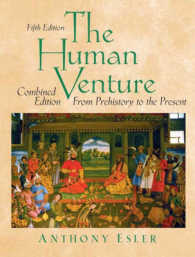- ホーム
- > 洋書
- > 英文書
- > Computer / General
Full Description
Computational Materials Engineering: Achieving High Accuracy and Efficiency in Metals Processing Simulations describes the most common computer modeling and simulation techniques used in metals processing, from so-called "fast" models to more advanced multiscale models, also evaluating possible methods for improving computational accuracy and efficiency.
Beginning with a discussion of conventional fast models like internal variable models for flow stress and microstructure evolution, the book moves on to advanced multiscale models, such as the CAFÉ method, which give insights into the phenomena occurring in materials in lower dimensional scales.
The book then delves into the various methods that have been developed to deal with problems, including long computing times, lack of proof of the uniqueness of the solution, difficulties with convergence of numerical procedures, local minima in the objective function, and ill-posed problems. It then concludes with suggestions on how to improve accuracy and efficiency in computational materials modeling, and a best practices guide for selecting the best model for a particular application.
Contents
1. Introduction2. Towards Increase of the Efficiency of Modelling (DSz)3. Conventional Modelling4. Identification of Material Models and Boundary Conditions5. Multiscale Modelling Methods6. Reduction of the Computational Domain7. Case Studies8. SummaryReferences






